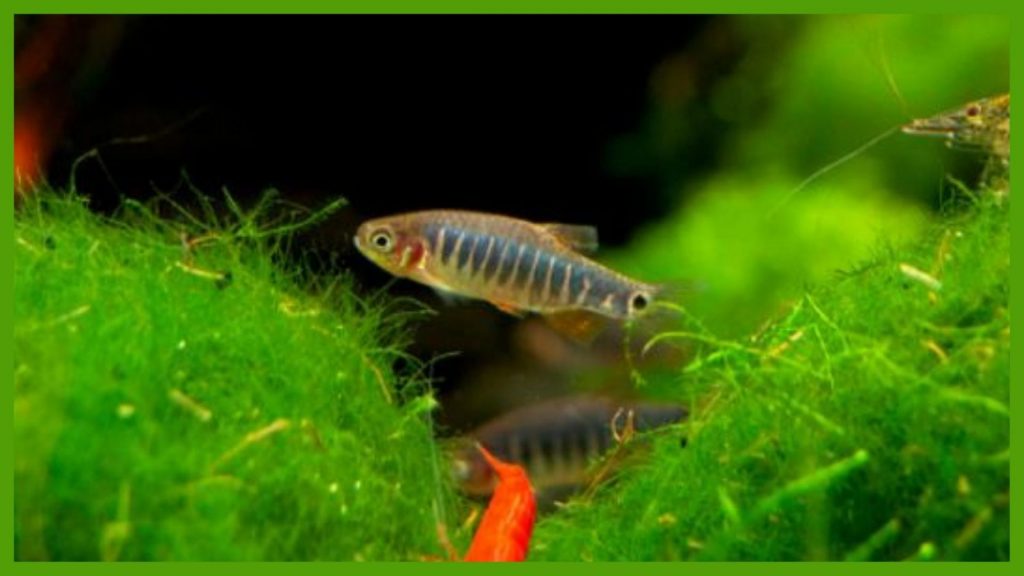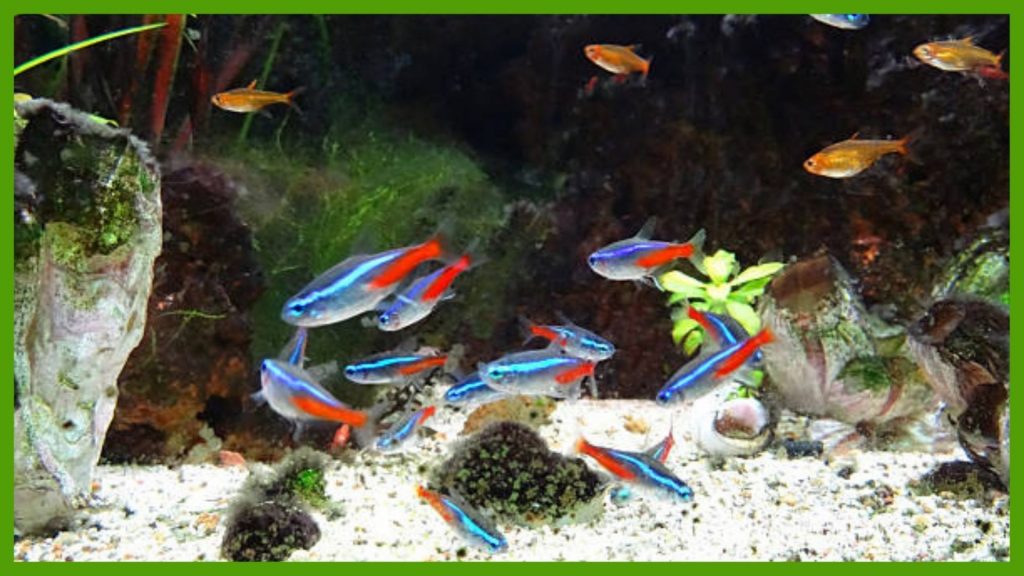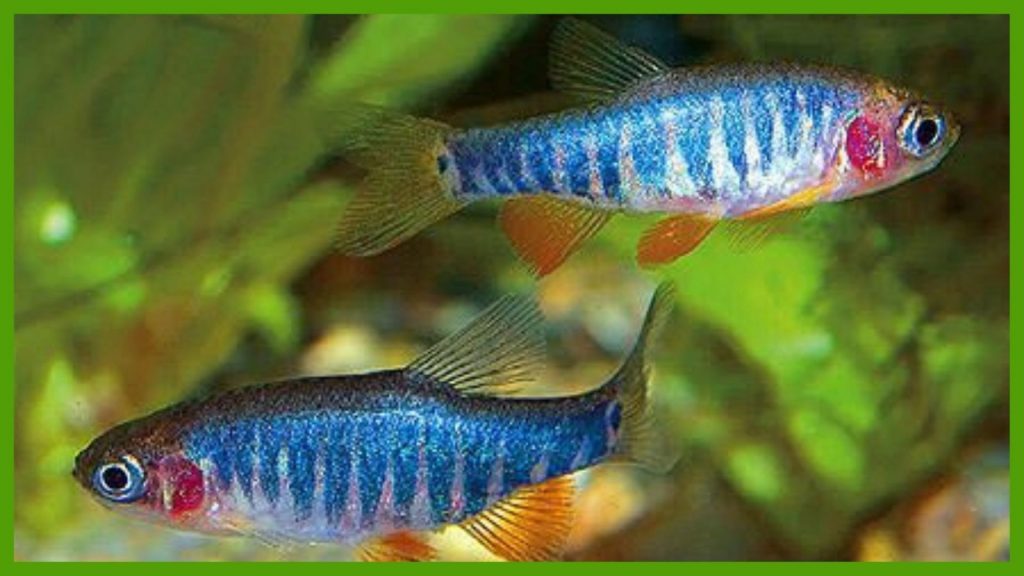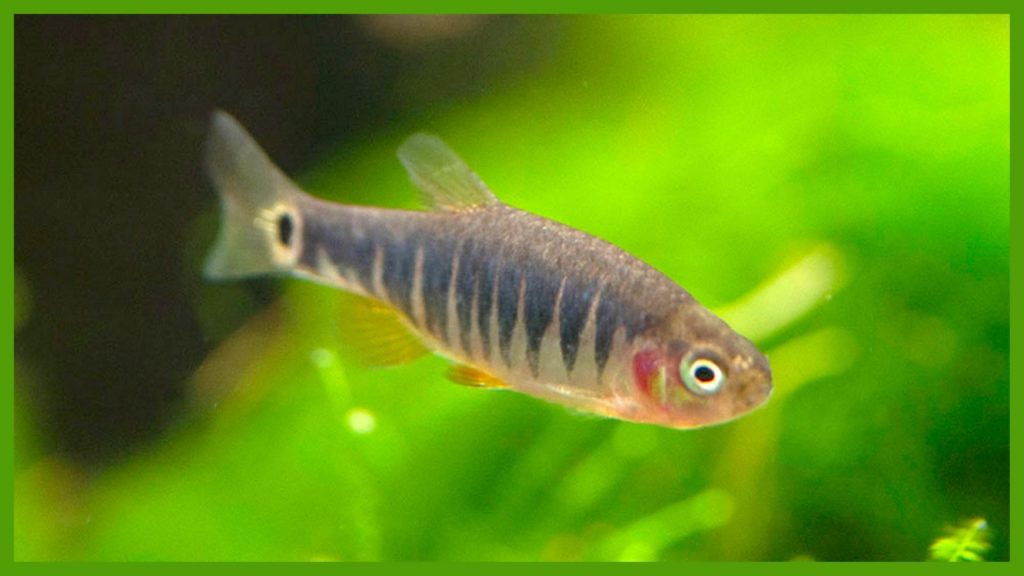I have used Amazon affiliate links on this page. As an Amazon Associate, I earn a commission from qualifying purchases at no added cost to you. Thank you!

Table of Contents
Introduction
Emerald Dwarf Rasbora is the perfect choice for any aquarium owner looking to add a lot of color and life to their aquariums. They’re relatively small, so we can keep them in smaller tanks, but even bigger tanks will look amazing with a school of these swimming around. This rasbora’s scientific name is Celestichthys erythromicron.
They are a popular choice if you want to fill your aquarium with color and life. It has a large personality, small size, and fascinating behavior. It is a schooling fish that constantly swims around the tank but stops often to hover and flare its gills, which makes you think it’s been caught in the light and captured on camera!
The Emerald Dwarf Rasbora hails from Myanmar, where it can be found in Lake Inle. Unfortunately, this beautiful fish is likely to be extinct in the wild in just a few more years as a result of human encroachment on its habitat and over-fishing. Luckily, breeders have been successful at keeping populations healthy, and the Emerald Dwarf Rasbora has made its way into many aquariums worldwide.
Appearance of Emerald Dwarf Rasbora

These delicate fish have a long and slender body with big shiny eyes, coupled with semi-transparent scales around their gill plate. The scales are extra protection for their gills. These fish have been known to be kept by experienced aquarists as community fish in a larger tank. Setup should ideally have an area of open water as well as densely planted areas. They enjoy the company of other smaller fish that are peaceful.
The Emerald Dwarf Rasbora has a slender, long-form covered in semi-transparent scales on its head and around the gill plate. Larger shimmering eyes occupy much of their tiny heads as well. However, what really sets this fish apart from others is its vibrant emerald green coloration on its thick stripes. But don’t be surprised to find fish with blue stripes as well, because the color of these beautiful stripes are vary among them. The green tone is very rich and complimented well by the body color which is typically coral pink or orange.
It might be hard to believe, but the Emerald Dwarf Rasbora is a case of incredible evolutionary adaptability. These fish have evolved over time to develop different kinds of behaviors and mimicry. One such mimicry is the “eye spot” on the base of their caudal fin. A lot of predatory fish have an attacking tactic from behind their prey fish. Now with our Dwarf Rasbora, such predators get confused trying to figure out the rear and front end of the fish, hence they tend to move on to find an easy target.
The Size
The average adult Emerald Dwarf Rasbora size is between 1 and 1.5 inches in length and not as big as other types of rasboras. Don’t worry to buy them young, because they grow rather quickly, so you’ll be able to enjoy them at their biggest after just a few months of having them! If you buy them young you can get them for cheaper and get to enjoy more of their lifespan while watching them grow.
Lifespan of Emerald Dwarf Rasbora
For such a smaller size, these fish live a longer life than other similar fish species. So, here’s the good news for the rasbora lovers. They have a lifespan of three to five years. But to ensure they reach their maximum life expectancy, you must keep them in ideal living conditions.
Do you love freshwater Angelfish? Then you must read about How long do angelfish live? And find out how to improve their lifespan.
Ideal Water Conditions for Emerald Dwarf Rasbora
- Temperature: 70° – 75° F (21° – 24° C)
- pH: 7.0 – 8.0
- KH: 2 – 10 dKH
Checkout below water testing kits:-
Thermometers can come in handy to determine exact aquarium temperatures:-
Minimmum Tank Size
When you’re shopping for a new fish tank, you’ll come across lots of different fish that can be great additions to your aquarium. For example, it’s good to know the minimum tank requirement of your fish before you get too attached. Some species need more space than others, but luckily, Emerald Dwarf Rasboras don’t need a lot of room!
So, If you’re looking for a small fish to add to your small aquarium, consider the Emerald Dwarf Rasbora. This fish is a great choice for beginners because they are easy to care for and do well in small, 10-gallon tanks. Since they have a long lifespan, it makes sense to make a natural habitat for them.
At petfish101 we recommend always going for bigger tank sizes than standards. Because when you have more room for your fish the better. It reduces possible crowded aquariums and the risk of spreading diseases. The bigger the tank bigger the space for your rasboras to roam around happily in shoals.
Emerald Dwarf Rasbora Ideal Habitat

It’s always best to mimic the natural habitat of your fish in your aquarium. This assures that they are happy and long-living. And also, it’s always the best for the eye!
As we mentioned before the Emerald Dwarf Rasbora’s natural habitat is Lake Inle, which is nestled in the high valleys of Myanmar. Their natural waters are crystal clear and around a neutral PH value.
To mimic their natural habitat, which is the calm waters of Southeast Asia, prepare a tank with plenty of plants(like water lettuce, hornwort, water sprite, Bacopa caroliniana, Java fern, and anubias barteri), driftwood, and caves for them to roam and hide. Because when the fish in small, sparse tanks often swim in a more skittish manner and then you are risking your fish with raising their stress levels. This eventually leads to various complications such as making them vulnerable to diseases. A spacious and lively tank gives them the confidence to engage in natural behavior like feeding and reproduction.
The substrate at the bottom of the tank should be a dark color so that it brings out the color of the Emerald Dwarf Rasbora. fine black sand substrate is best as gravel can cause problems for our little fish friends. The loam of Lake Inle is made up of fine sand and is where they are found in nature. (But you shouldn’t worry much if you cant find the sand)
Temperement
As their name may suggest, Emerald Dwarf Rasboras are about half the size of a regular size rasbora species. That makes them perfect for nano tanks, or even as a community fish in a 10-gallon tank. They’re also incredibly social and they do best when kept in a school of six or more. Since they’re not big fish, they don’t need a ton of space to stay happy and at peace with others.
This is a peaceful fish, you can keep them with other easy-going species. This species is perfect for fishkeepers who are new to aquarium keeping. In general, these fish prefer a group of at least six, though they will display more of their true characters in larger groups.
Emerald Dwarf Rasboras Tankmates

As these fish are very peaceful community fish species, we can keep them with a variety of small fish around the same size. But make sure to not add these fish with bigger, more aggressive fish as they may get eaten.
These fish peacefully form nice schools with each other and with other rasboras species and danios.
Below is a general list of tank mates that we can keep with our Dwarf Rasboras.
- Neon Tetra
- Sawbwa Barb.
- Cherry Barb
- Celestial Pearl Danio.
- Red Dwarf Rasbora.
- Dario Hysginon.
- Glowlight Danio.
- Panda Guppy
- Clown Killifish
- Ember Tetra
- Pygmy Corydoras
- Chili Rasbora
- Snails.
- Cherry Shrimp.
Diet of the Emerald Dwarf Rasboras
Emerald Dwarf Rasboras require an appropriate mixture of both meaty and vegetable-based foods. Flake food will suit their omnivorous needs, but adding tiny amounts of frozen or fresh vegetables to the tank, along with living plants like algae, will ensure that their appetite is fully satisfied.
Emerald dwarf rasboras are tropical fish that feed on small aquatic insects. While they will usually devour dry food like flakes and fish food pellets as their base diet, they most enjoy foods that provide higher protein content, foods like bloodworms, daphnia, and krill. This makes it a good idea to provide them with some goodies every now and then, it not only provides enrichment, but it also helps keep your little ones healthy.
Breeding

It’s easy to breed Emerald Dwarf Rasboras. These fish are egg-scatterers and will breed in pristine conditions. However, they don’t have parental instincts so things might get a little messy after the spawning!
You need a separate breeding tank for the breeding to be successful. Otherwise, other fish will feed on their eggs after spawning. And the eggs that somehow get uneaten will catch fungus before the hatching is complete.
First of all, let the fish pair out. It’s a process prior to mating when females and males bond with each other. Feeding them with protein-rich food can encourage breeding.
Then create an ideal breeding environment in their breeding tank. Temperature, water quality, and dietary requirements must be met before the parent fish are added to the tank. A spawning mop or leafy plant should be placed in the breeding tank, which is then filled with well-cycled water with no ammonia or nitrites. Bonded pairs of fish should be then added to this breeding setup. If you don’t yet have bonded fish, then add a group of Emerald Dwarf Rasbora, ideally with two males and several females.
When it comes to breeding these fish, the location is paramount. The breeding tank should be set up in a room without noise or traffic.
One female can lay eggs around 30. They are sticky and will stick onto plants, leaves, and gravel.
Once they have laid eggs you should put the breeder fish back to the main tank.
Add a few drops of methylene blue into the breeding tank. This must turn the watercolor into soft sky blue. Methalyn Blue will ensure the tiny eggs from catching fungus. You should also put an air stone in a corner of the breeding tank. This will ensure the eggs will get enough oxygen and the gentle water flows created will keep the eggs clean.
The fry should hatch within 3 days. And they will feed on their egg sack for three to four days. After they run out of their egg sack don’t just start feeding them brine shrimps. A lot of fish fry can catch and eat brine shrimp but the Emerald Dwarf Rasbora fry are too small and weak to do the same. So you can feed them powdered fish food or infusoria until they are ready from brine shrimp.
Diseases of Emerald Dwarf Rasbora

These fish can get many diseases just like other small freshwater fish. These include parasitic infections, bacterial infections, and fungus.
Common diseases are Ich, Fish fluke, Swim bladder disease, and other bacterial infections.
You can easily treat Ich by slightly raising the water temperature. This will accelerate the life cycle of ich parasite. You should perform frequent water changes as you are treating for ich. The parasite has a free-swimming stage of its life cycle and you can effectively remove them by doing water changes.
For bacterial infections, you can use aquarium antibiotics like Tetracycline. But using antibiotics must be done with precautions and should be your last resort. Antibiotics can kill all the bacteria including beneficial bacteria in your aquarium and mess up your cycled tank and bio filter.
Disease prevention
Preventing diseases is always better than treating them. A key of preventing diseases of Emerald Dwarf Rasbora and other fish is to have clean water with ideal water parameters. When the water is dirty and out of ideal conditions diseases can spread like wild fires. This gets worse is small aquariums and overcrowded aquariums. Some patahgeons are already living in your fish tank but only attack healthy fish when the water conditions go off. Ich is an excellent example.
The other key to disease prevention is qurentine any new fish, plants and aquascaping material like driftwood. They can introduce deadly bacteria and parasites in to your healthy aquarium.
Conclusion
Emerald Dwarf Rasbora is a beautiful little fish that suits to planted tanks nano fish tanks. They make great community aquariums with other rasboras and fish around the same size. They are easy to care for and easy to breed. Given the right conditions and food these fish can satisfy any hobbyst’s expectations and they can live up their full lifespan. We hope this guide has helped you in your query, if you have more questions and stories to share please comment and visit our forum. Thank you!
